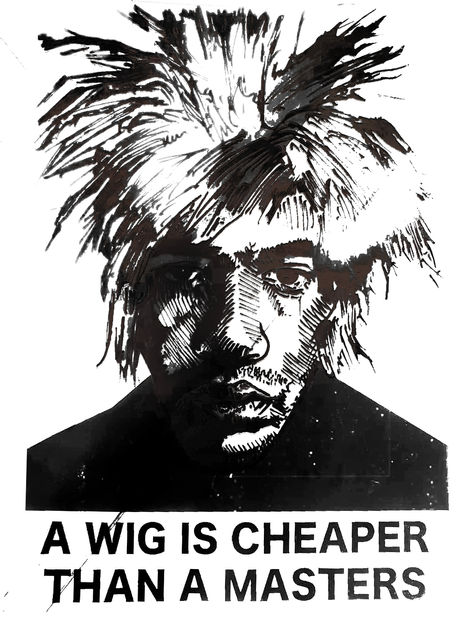A WIG IS CHEAPER THAN A MASTERS
Chasing the African dream,
Or a nightmare—who's to say?
Tuition climbing like a rabid beast,
But a wig? That’s a one-time pay.
Strap it on, fool the masses,
Step into the theater of life.
No textbooks, no theses,
Just synthetic threads and a plastic knife.
A master's costs your soul and more,
Promises draped in ivory tower's lore.
But a wig? Slip it on, disguise for the night,
Cheaper than debt, and almost as light.
Degrees hang like a sword, ready to fall,
But a wig—hell, it’s got you covered after all.
The endeavor to disrupt and occupy the space of the Wits Art Museum was conceived as a deliberate intervention against the established norms within this institution. The critique I, along with others, levy against the Wits Art Museum is its reinforcement of the power dynamics that subjugate artists within the sterile confines of the "white cube." Wits Art Museum, like many other such spaces, prescribes which art is to be revered, treasured, and valued—a process inherently problematic when it perpetuates a predominant Eurocentric and Amerocentric master narrative, dictated by the gatekeepers of the institution.
This double standard crystallized in my mind when the museum hosted a one-month exhibition of Andy Warhol’s work. The criteria for gaining exhibition space at WAM are clear: one must either possess a master’s degree from the University or engage in an artistic practice that elevates the artist to a pedestal of institutional approval. For the latter, three conditions must be met:
-
The artistic practice must amass significant social capital within the appropriate circles (HYPE).
-
The practice must attain substantial monetary value.
-
The artist must conform to a stylistic and conceptual mold that echoes the Eurocentric narrative.
Once these criteria are met, an exhibition becomes possible. Alternatively, one may choose to pay exorbitant fees to be awarded a master’s degree, securing a place within the institution’s hierarchy.
My silkscreen piece interrogates this notion of subjugated space. The image, a self-portrait donning Andy Warhol’s iconic wig, replicates his mechanical, flat style, embracing the imperfections of the printing process—a homage to Warhol's own methods. I deliberately did not clean the screen during printing, allowing for overflooding and blurred details, producing seven editions, selecting the one most reminiscent of Warhol. Concealing the print beneath my clothing, I surreptitiously introduced it into WAM, positioning it beside an artist who epitomizes the three prerequisites for exhibiting in this space: Wayne Barker.
The production of seven editions served a tactical purpose: should security or the gallery director remove the work, I would replace it with another, emulating the guerrilla tactics of BANKSY, who famously infiltrated the Tate Modern. This intervention, encapsulated by the phrase “a WIG is cheaper than a master’s,” critiques the institutional pressures that demand one pay their way into the art world. Instead, I advocate for forcibly inserting oneself into these spaces through compelling work that demands attention and recognition.




